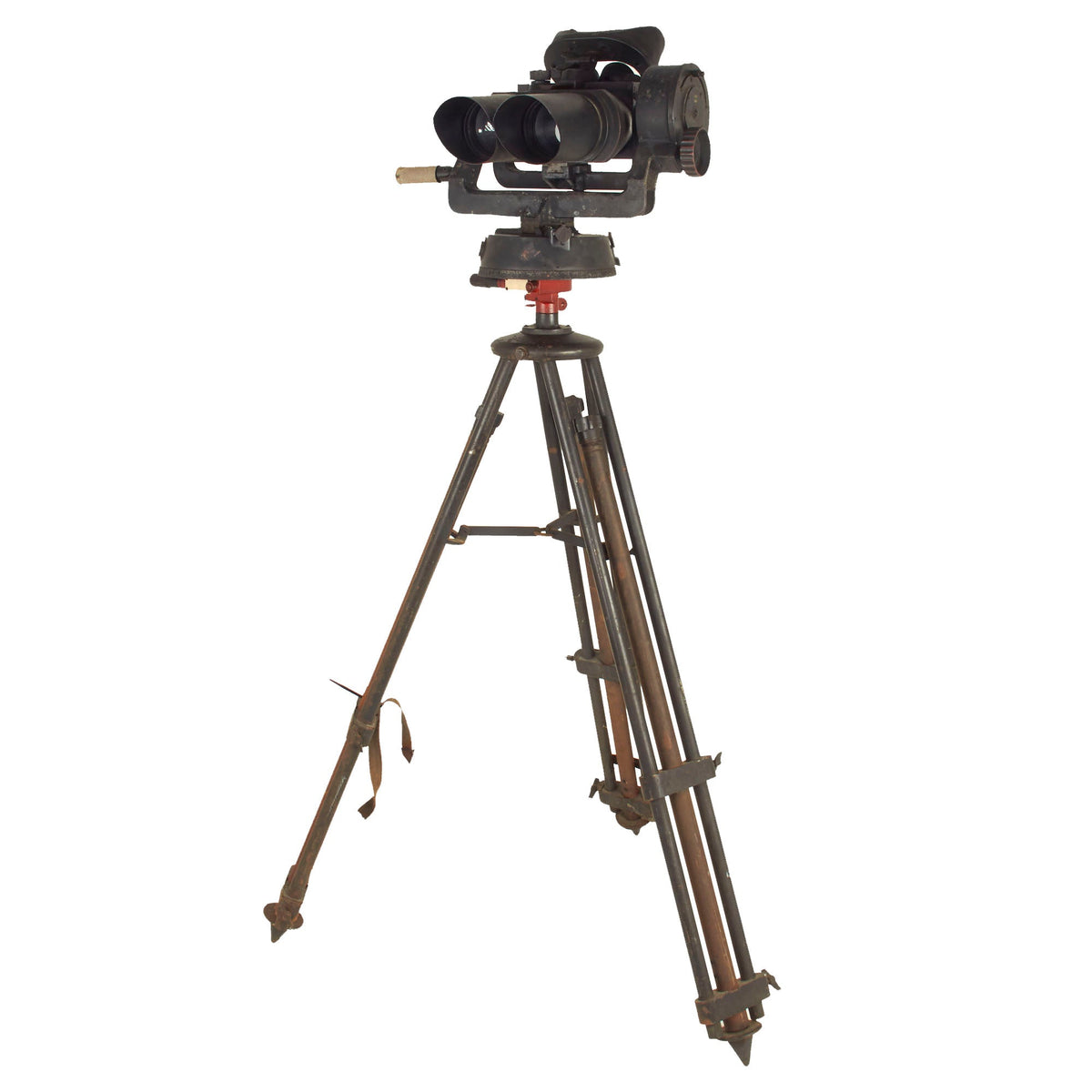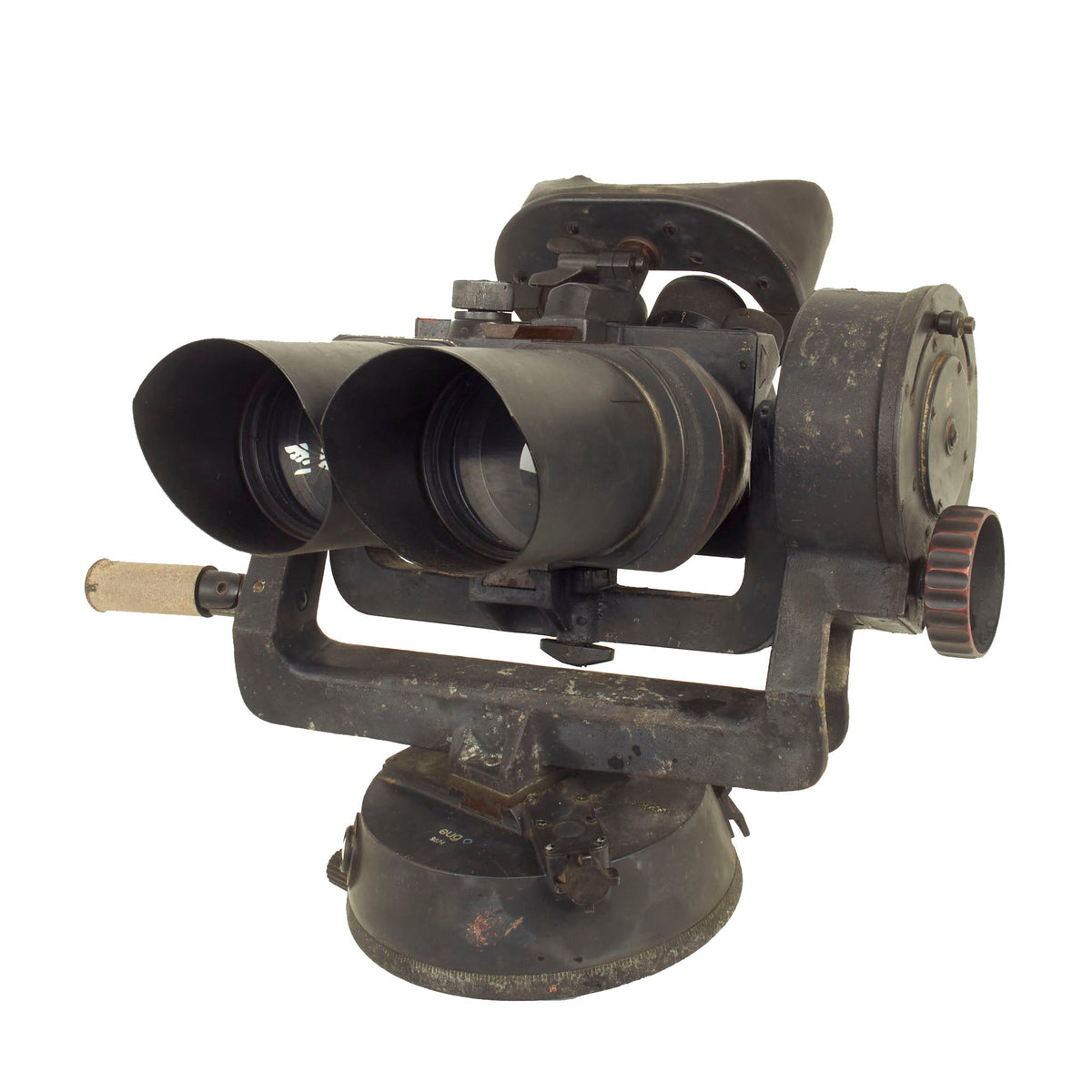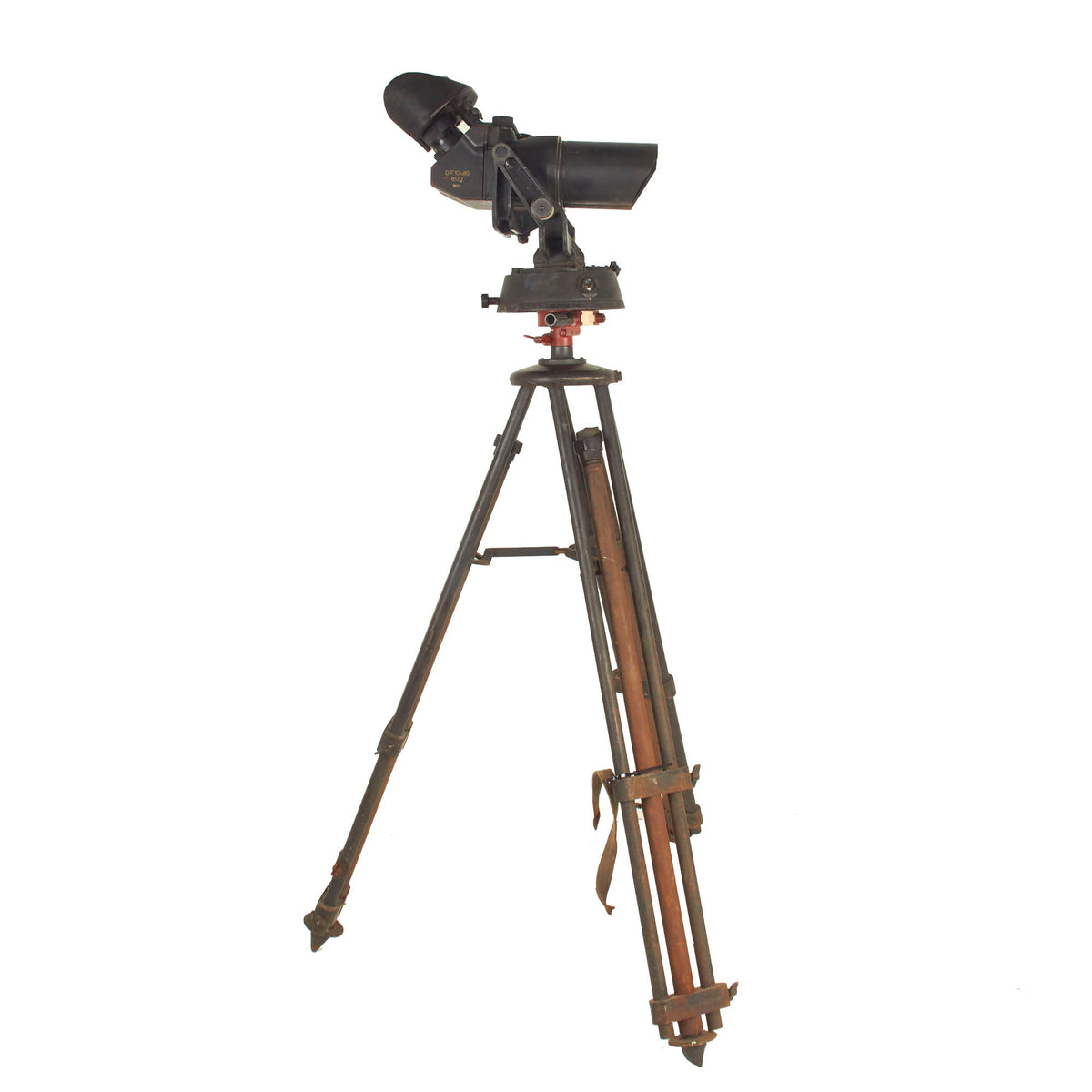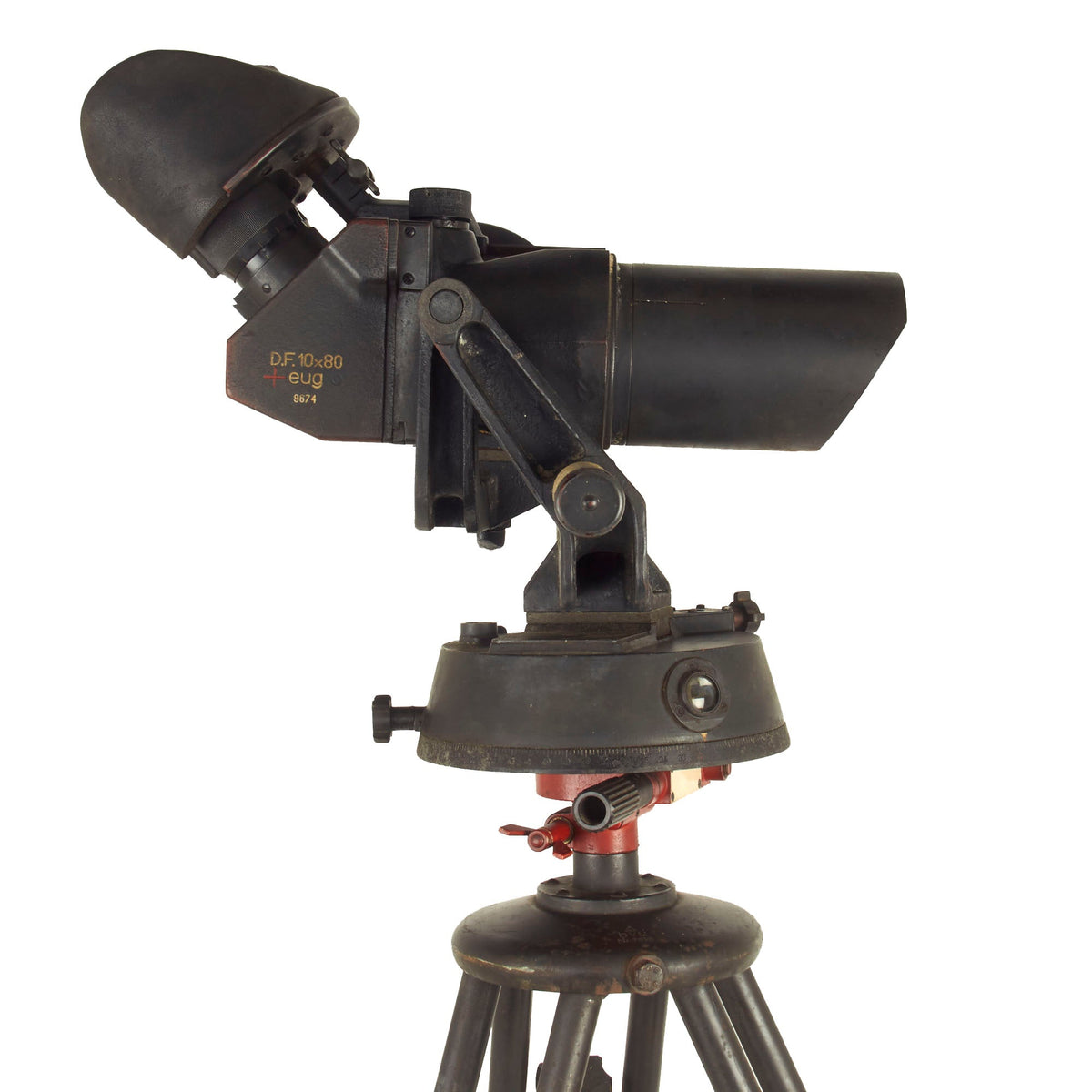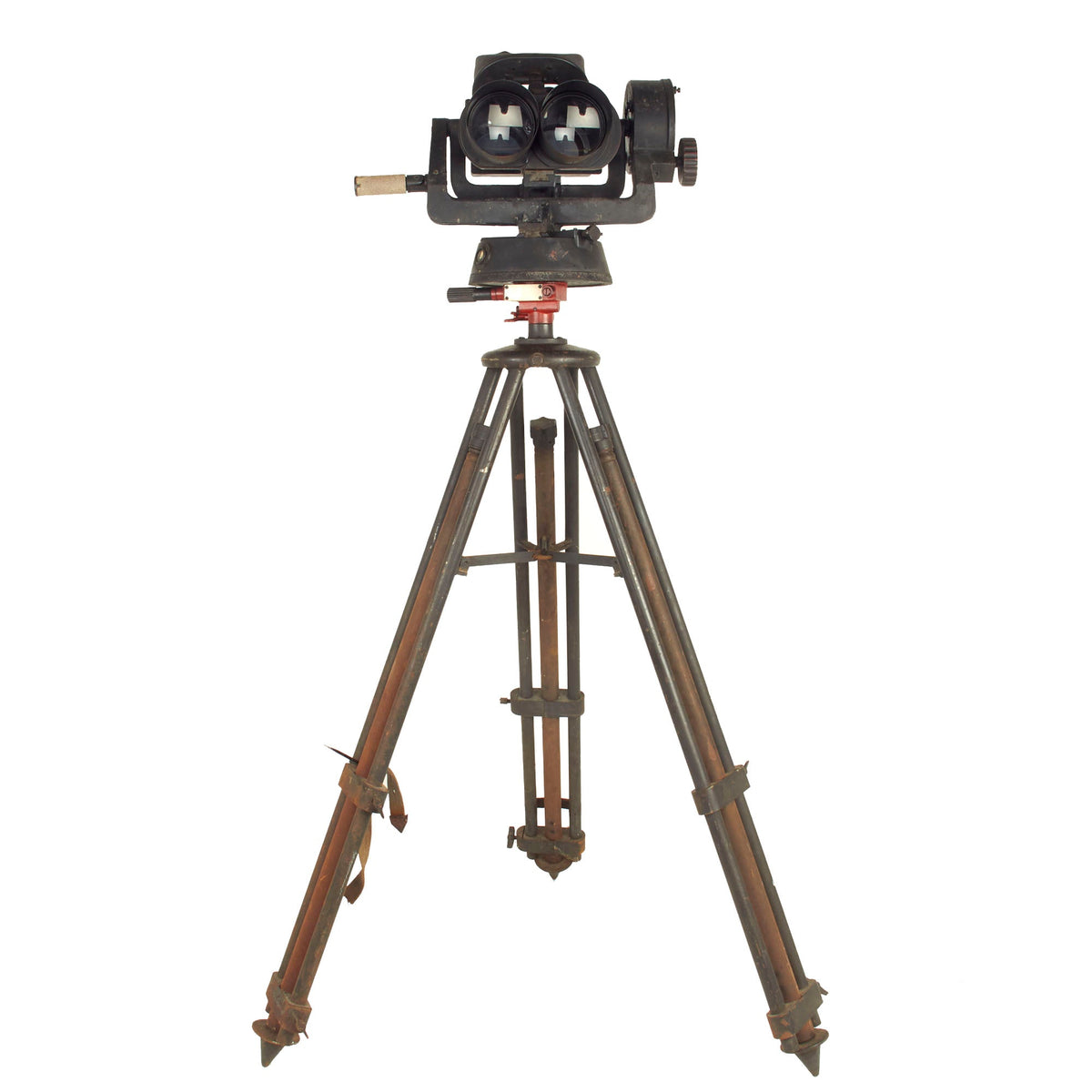Original German WWII Luftwaffe Flak D.F. 10 x 80 Binocular Optics by Optische Präzisions-Werke with Complete Tripod & Azimuth Original Items
$ 3.495,00 $ 873,75
Original Item: Only One Set Available. This is a great pair of German World War Two Doppelfernrohr (double telescope) 10 x 80 German gun sight binoculars (flakfernrohr), as part of the most complete set that we have ever had! These were used for direct sighting on the German Flak 36 (88 mm) Gun and are offered in very good condition. They painted a lovely deep gray blue finish, the typical color for Luftwaffe equipment. There is some wear, so the correct red primer can be seen in areas.
They come complete with the mount cradle, which displays the elevation on the left side as the binoculars are moved. This in tern is attached to the top of the correct azimuth turntable, which allows for precise adjustment of the side to side angle. This in turn is mounted on top of the proper tripod, which still has three functional legs, and looks to have intact bubble levels as well. We have never had a more complete set for one of these Luftwaffe Flak optics, and we doubt that we will again!
Most commonly seen being used by the KRIEGSMARINE (German Navy) on Ship Bridges and on Conning Towers of U-Boats, these are the giant 10 x 80 Binoculars so much favored in WW2. The binoculars themselves are in very good condition, and are definitely a great example of the D.F. 10×80, of which we have had several before. There are adjustments for eye relief, width and a selection of various tinted filters, which rotate into place using the control on the left side. The dial is labeled klar (clear), hell (light), mittel (medium), and dunkel (dark). In a typical example of German WW2 era (over)engineering, the control actually controls a mechanism that swings each individual filter in place on both sides simultaneously. A more modest implementation with filters that were fitted over the eye pieces would have probably been more economical. The filters still move correctly, and we did not notice any sticking or sluggishness as we often do.
The Steel Sun Shades are still present and in good condition, and are removable if so desired. This set also includes the original padded head rest/shade, which is still soft, with minimal cracking, which can also be removed.
The right side of the binocular body is marked:
D.F. 10×80
✚ eug o
9674
“D.F.” Is the abbreviation for Doppelfernrohr (double telescope), with 10 x 80 indicating the magnification power of the optics. The German wartime three letter code eug indicates manufacture by Optische Präzisions-Werke (Optical Precision Works) GmbH in Warschau (Warsaw), Poland. As this uses a three letter code, it was made post 1941. We have not been able to find much information about this company, except that during World War II, it was under the control of Carl Zeiss director, producing the unrivaled caliber of optical lenses. However it also possibly employed forced labor from the Warsaw ghetto. The colored symbols on either side of the maker indicate the type of lubricants to be used on the binoculars.
The mount cradle and the azimuth both bear the same maker and serial number, making this a “matched set”. These would be stored in a transit chest together, which was kept separately from the tripod it mounted to. We have had one such chest set previously, though unfortunately we do not have the transit chest for this example.
The tripod portion of the set is maker marked bvu Nr. 7898, for manufacture by Franz Kuhlmann, Werkstaetten für Präzisionsmechanik und. Maschinenbau (workshops for precision mechanics and mechanical engineering), Hauptwerke (Headquarters) Wilhelmshaven. This was a known maker of artillery levels and sighting tripods, and is exactly the type of firm that would have made this tripod.
This set is fully operational, with partly clear optics, which show some discoloration and haze when you look through them. We assume that they just need a cleaning and servicing, which they probably have not had since WWII. The set has fully functional focus and width adjustments, and the filters move into place easily. The cradle and azimuth are also fully functional as well, and the leveling adjustments on the tripod legs are also functional. Overall condition of the set is very good, with lovely paint, and some oxidation on the center portion of the tripod legs. We have not made any attempts to clean or service any part of the set to preserve the patina.
A magnificent set, ready to display or even use!
Fast Shipping with Professional Packaging
Thanks to our longstanding association with UPS FedEx DHL, and other major international carriers, we are able to provide a range of shipping options. Our warehouse staff is expertly trained and will wrap your products according to our exact and precise specifications. Prior to shipping, your goods will be thoroughly examined and securely secured. We ship to thousands clients each day across multiple countries. This shows how we're dedicated to be the largest retailer on the internet. Warehouses and distribution centres can be located throughout Europe as well as the USA.
Note: Orders with more than one item will be assigned a processing date depending on the item.
Before shipping before shipping, we'll conduct a thorough inspection of the items you have ordered. Today, the majority of orders will be delivered within 48 hours. The delivery time will be between 3-7 days.
Returns
The stock is dynamic and we cannot completely manage it because multiple stakeholders are involved, including our factory and warehouse. So the actual stock may alter at any time. It's possible that you may not receive your order once the order has been made.
Our policy is valid for a period of 30 days. If you don't receive the product within 30 days, we are not able to issue a refund or an exchange.
You can only return an item if it is unused and in the same state as the day you received it. You must have the item in its original packaging.
Related products
Uncategorized
Uncategorized
Uncategorized
Uncategorized
Uncategorized
Uncategorized
Australian WWII Owen MK1 Machine Carbine SMG Custom Fabricated Replica with Sling Original Items
Uncategorized
Uncategorized
Uncategorized
Uncategorized
Uncategorized
Uncategorized
Uncategorized
Uncategorized
Uncategorized
Uncategorized
Uncategorized
Angolan Rebel 1970s era 60mm Inert Display Mortar from Angolan Civil War Original Items
Uncategorized
Armoured Fighting Vehicles of the World: AFVs of World War One (Hardcover Book) New Made Items
